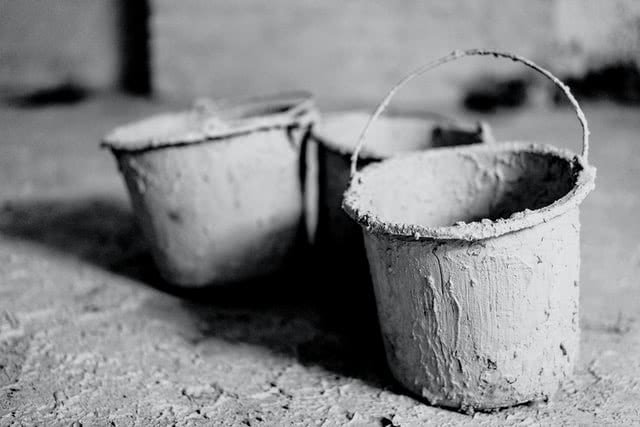In this post I talked about the riddle of the water buckets. Now I challenge you to prove that in some situations it is impossible to solve it!

Problem statement
You have \(n\) buckets, each bucket with capacity for \(c_i\) litres of water, \(i = 1, \cdots, n\). You want to manipulate the buckets in such a way that one of them holds exactly \(t\) litres of water, knowing that the only moves you can do are:
- completely fill up bucket \(i\) so that it holds \(c_i\) litres of water;
- completely empty bucket \(i\) so that it now holds \(0\) litres of water;
- move water from bucket \(i\) to bucket \(j\), until bucket \(i\) becomes empty or bucket \(j\) becomes full, whatever happens first.
Prove that, if \(t\) is not a multiple of the greatest common divisor of the \(c_i\), \(i = 1, \cdots, n\) then it is impossible for a single bucket to hold exactly \(t\) litres of water.
For example, if the buckets have capacities \(4\) and \(6\) and \(t = 3\), then you can't perform the moves above to get exactly \(3\) litres of water into one of the two buckets as the greatest common divisor of \(4\) and \(6\) is \(\gcd(4, 6) = 2\) and \(3\) is not a multiple of \(2\).
Give it some thought... and give it an actual shot! Take out a piece of paper and a pencil and get your brain working!
If you need any clarification whatsoever, feel free to ask in the comment section below.
Solution
A possible solution is to consider a clever invariant that applies to the amount of water that each bucket is holding at any point in time. To make this easier, let's call \(d\) to the greatest common divisor of the \(c_i\), \(i = 1, \cdots, n\) (\(d = \gcd(c_1, \cdots, c_n)\)). Let's also say the amount of water in bucket \(i\) is \(w_i\). We will show that, regardless of the moves we make, \(w_i\) is always a multiple of \(d\) for all \(i\) (which we write \(d | w_i\) for _"\(d\) divides \(w_i\)"_).
At the start all buckets are empty, so \(w_1 = \cdots = w_n = 0\) and \(0\) is a multiple of \(d\) so that is that. Now we show that the three moves above preserve this property that \(d | w_i\ \forall i\).
- Emptying bucket \(i\): this means \(w_i = 0\) and \(d | 0\) so everything is good;
- Filling bucket \(i\): this means \(w_i = c_i\) but, by definition, \(d\) is a divisor of \(c_i\) so certainly we have \(d | c_i\);
- Moving water from bucket \(i\) to bucket \(j\) until either bucket \(i\) becomes empty or bucket \(j\) becomes full, whatever happens first: before we move water around we have that \(d | w_i\), \(d | w_j\) so we can say that \(w_i = k_i d\) and \(w_j = k_j d\) for some integer values of \(k_i, k_j\). Now when we start moving the water, we have to analyze what happens depending on whether bucket \(i\) becomes empty and \(j\) is not full yet or bucket \(j\) becomes full while \(i\) possibly has some water left:
- if bucket \(i\) becomes empty then \(w_i = 0\) and \(w_j = (k_i d) + (k_j d) = (k_i + k_j) d\); \(d | 0\) and \(d | (k_i + k_j) d\) so everything stays a multiple of \(d\);
- if bucket \(j\) got full, then \(w_j = c_j\) and \(d | c_j\), so this is ok; we just need to check if the amount of water left in bucket \(i\) is a multiple of \(d\) or not. Well, bucket \(j\) had \(k_j d\) water and now has \(c_j\), so bucket \(i\) gave \(c_j - k_j d\) water to bucket \(j\). If bucket \(i\) had \(k_i d\) water it now has \(w_i = k_i d - (c_j - k_j d)\). But this is still a multiple of \(d\) because \(c_j\) was! We can write \(c_j = k d\) with \(k\) integer, showing that \(w_i = k_i d - (c_j - k_j d) = d(k_i - k + k_j)\) is a multiple of \(d\)!
We showed that no matter what we do, the amount of water in a bucket is always a multiple of \(d\), so if \(t\) is not a multiple of \(d\) this means we can never have a single bucket holding \(t\) litres of water...
Become a better Python 🐍 developer 🚀
+35 chapters. +400 pages. Hundreds of examples. Over 30,000 readers!
My book “Pydon'ts” teaches you how to write elegant, expressive, and Pythonic code, to help you become a better developer. >>> Download it here 🐍🚀.
